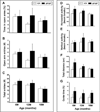Deletion of the huntingtin proline-rich region does not significantly affect normal huntingtin function in mice
- PMID: 22956985
- PMCID: PMC3432989
- DOI: 10.3233/JHD-2012-120016
Deletion of the huntingtin proline-rich region does not significantly affect normal huntingtin function in mice
Abstract
The N-terminus of Huntingtin, the protein encoded by the Huntington's disease gene, contains a stretch of polyglutamine residues that is expanded in Huntington's disease. The polyglutamine stretch is flanked by two conserved protein domains in vertebrates: an N1-17 domain, and a proline-rich region (PRR). The PRR can modulate the structure of the adjacent polyglutamine stretch, and is a binding site for several interacting proteins. To determine the role of the PRR in Huntingtin function, we have generated a knock-in allele of the mouse Huntington's disease gene homolog that expresses full-length normal huntingtin lacking the PRR. Mice that are homozygous for the huntingtin PRR deletion are born at the normal Mendelian frequency, suggesting that the PRR is not required for essential huntingtin functions during embryonic development. Moreover, adult homozygous mutants did not exhibit any significant differences from wild-type controls in general motor function and motor learning. However, 18 month-old male, but not female, homozygous PRR deletion mutants exhibited deficits in the Morris water task, suggesting that age-dependent spatial learning and memory may be affected in a sex-specific fashion by the huntingtin PRR deletion.
Conflict of interest statement
Conflict of interest statement
The authors have no conflicts of interest arising from the publication of this paper.
Figures






Similar articles
-
Generation and Characterization of Knock-in Mouse Models Expressing Versions of Huntingtin with Either an N17 or a Combined PolyQ and Proline-Rich Region Deletion.J Huntingtons Dis. 2017;6(1):47-62. doi: 10.3233/JHD-160231. J Huntingtons Dis. 2017. PMID: 28211815 Free PMC article.
-
A series of N-terminal epitope tagged Hdh knock-in alleles expressing normal and mutant huntingtin: their application to understanding the effect of increasing the length of normal Huntingtin's polyglutamine stretch on CAG140 mouse model pathogenesis.Mol Brain. 2012 Aug 14;5:28. doi: 10.1186/1756-6606-5-28. Mol Brain. 2012. PMID: 22892315 Free PMC article.
-
Deletion of the huntingtin polyglutamine stretch enhances neuronal autophagy and longevity in mice.PLoS Genet. 2010 Feb 5;6(2):e1000838. doi: 10.1371/journal.pgen.1000838. PLoS Genet. 2010. PMID: 20140187 Free PMC article.
-
Molecular aspects of Huntington's disease.J Neurosci Res. 1998 Nov 1;54(3):301-8. doi: 10.1002/(SICI)1097-4547(19981101)54:3<301::AID-JNR1>3.0.CO;2-W. J Neurosci Res. 1998. PMID: 9819135 Review.
-
[Huntington's disease: intracellular signaling pathways and neuronal death].J Soc Biol. 2005;199(3):247-51. doi: 10.1051/jbio:2005026. J Soc Biol. 2005. PMID: 16471265 Review. French.
Cited by
-
Huntington's disease: the past, present, and future search for disease modifiers.Yale J Biol Med. 2013 Jun 13;86(2):217-33. Print 2013 Jun. Yale J Biol Med. 2013. PMID: 23766742 Free PMC article. Review.
-
Huntingtin exon 1 deletion does not alter the subcellular distribution of huntingtin and gene transcription in mice.Front Cell Neurosci. 2022 Nov 10;16:1021592. doi: 10.3389/fncel.2022.1021592. eCollection 2022. Front Cell Neurosci. 2022. PMID: 36439204 Free PMC article.
-
N17 Modifies mutant Huntingtin nuclear pathogenesis and severity of disease in HD BAC transgenic mice.Neuron. 2015 Feb 18;85(4):726-41. doi: 10.1016/j.neuron.2015.01.008. Epub 2015 Feb 5. Neuron. 2015. PMID: 25661181 Free PMC article.
-
Modulating FKBP5/FKBP51 and autophagy lowers HTT (huntingtin) levels.Autophagy. 2021 Dec;17(12):4119-4140. doi: 10.1080/15548627.2021.1904489. Epub 2021 May 24. Autophagy. 2021. PMID: 34024231 Free PMC article.
-
Ablation of huntingtin in adult neurons is nondeleterious but its depletion in young mice causes acute pancreatitis.Proc Natl Acad Sci U S A. 2016 Mar 22;113(12):3359-64. doi: 10.1073/pnas.1524575113. Epub 2016 Mar 7. Proc Natl Acad Sci U S A. 2016. PMID: 26951659 Free PMC article.
References
-
- Pecheux C, Gall AL, Kaplan JC, Dode C. Sequence analysis of the CAG triplet repeats region in the Huntington disease gene (IT15) in several mammalian species. Ann Genet. 1996;39(2):81–86. - PubMed
-
- Karlovich CA, John RM, Ramirez L, Stainier DY, Myers RM. Characterization of the Huntington's disease (HD) gene homologue in the zebrafish Danio rerio. Gene. 1998 Sep 14;217(1–2):117–125. - PubMed
-
- Baxendale S, Abdulla S, Elgar G, Buck D, Berks M, Micklem G, Durbin R, Bates G, Brenner S, Beck S. Comparative sequence analysis of the human and pufferfish Huntington's disease genes. Nat Genet. 1995 May;10(1):67–76. - PubMed
-
- Li Z, Karlovich CA, Fish MP, Scott MP, Myers RM. A putative Drosophila homolog of the Huntington's disease gene. Hum Mol Genet. 1999 Sep;8(9):1807–1815. - PubMed
Publication types
MeSH terms
Substances
Grants and funding
LinkOut - more resources
Full Text Sources
Molecular Biology Databases

